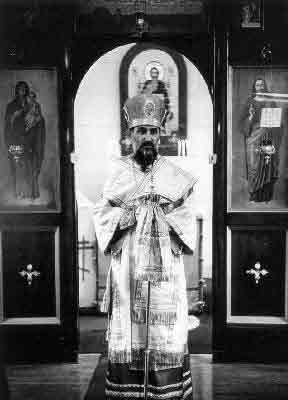

|
| Photo: Protopresbyter Andrew at St Michael's. |
Fr. Andrew Rogosh arrived in New York at Christmas of 1935 in order to establish an apostolate to serve the needs of the emigre Russian Catholics who had made their way to the New York metropolitan area after the tragic upheavals in their homeland. In the following months of 1936 he began the work of establishing a chapel, and soon thereafter St. Michael's Russian Catholic Chapel opened its doors at 266 Mulberry Street in Manhattan in order to serve their needs.
Soon thereafter, World War II sent a new wave of Russian immigrants to New York, and Fr. Rogosh was in position to help give them spiritual comfort, often travelling to the various processing camps for displaced persons to seek them out and help them get settled. The inherent beauty of the Russian liturgies and chant soon attracted many others, Russian and non-Russian, to the little building on Mulberry Street.
Fr. Rogosh died on October 17, 1969 and for a period of nearly ten years the community of St. Michael's was served by the Byzantine Rite Jesuits from the John XXIII Center at Fordham.
Among those who served at St. Michael's during those years were Fr. Wilcock, Fr. John Geary, and Fr. Walter Ciszek, whose first visit to the chapel was on the day of his return to New York after his release from the USSR in 1963.
From 1974, a new wave of Russian immigration came to New York. A few of these people decided to come to St. Michael's. In 1979, Fr. Joseph Lombardi, S.J., a former parishioner of St. Michael's and one of its many vocations, agreed to become the Administrator of the community. He was assisted in his work by Fr. Romanos Russo, a priest of the Melkite eparchy well versed in the Russian Church. In 1988, the Oriental Congregation sent Fr. John Soles, a Russicum graduate who had been serving in the Russian Catholic parishes in Europe, to be the Rector of St. Michael's. Soon after Fr. John's arrival, the momentous end of the Cold War in 1989 and 1990 led to a wave of Russian immigration to the New York metropolitan area. The need for St. Michael's and its apostolate continues.

|
| Photo: Bishop Andrei Katkoff preaching at St Michael's. |
St. Michael's has always attracted not only Russians seeking to maintain their spiritual roots while finding their way in American society, but also many non-Russians who were attracted to the richness and beauty of Russian spirituality.
For such a small church, it certainly attracted the attention of some well known persons. Helen Izwolsky, the daughter of a Czarist diplomat, a Sorbonne graduate and author of several books and articles, was on the faculty at Fordham University and was a friend of Dorothy Day and Catherine de Hueck Dougherty. Dorothy Day frequently attended Vespers or the Divine Liturgy with several of her fellow Catholic Workers. Catherine de Hueck Dougherty, who went on to found Madonna House in Canada and who has written several practical works on prayer and spirituality which rely heavily on her Russian roots (e.g.,"Poustinia"), was also attended during her later days in New York. On occasion during his younger years, Thomas Merton came to St. Michael's to share in the Divine Liturgy with us.
In 1986, St. Michael's was honored by a visit from His Beatitude Patriarch Maximos V of Antioch, Alexandria and Jerusalem, the Patriarch of the Melkite Catholic Church. In addition to the Patriarch, we have celebrated Pontifical Divine Liturgies on the occasion of their visits to St. Michael's with Bishop Anarghyros Printesis, the Greek Catholic Exarch of Greece (1988), Bishop Louis Puscas, Romanian Catholic Bishop of the Eparchy of Canton (1988), and Bishop Basil Losten, Ukrainian Catholic Bishop of Stamford (in 1996 and again in 1997). Cardinal Tisserant visited St. Michael's while on a trip to New York in the 1950's. Cardinal Lourdasami visited St. Michael's in 1987. John Cardinal O'Connor came to St. Michael's in 1986 to take part in our fiftieth anniversary celebration.
St. Michael's has been compared to a mustard seed yielding great amounts of its fruit or to a small lump of leaven that raises the bread. Such a small community has produced a number of vocations out of all proportion to its size and circumstances. So far, eight priests, one deacon, three readers, and several nuns have come from this humble community. We pray that we will be able to send many more workers into the Lord's vineyard.
Our community is growing, and in doing so, it is outgrowing our present quarters. As we prepare to solve our space problems, we keep ever in mind that what makes our community, our parish, so special is not the small room in which we gather, but the people who come together there to pray, to worship, and to live their lives according to Christ's greatest commandment, love.
